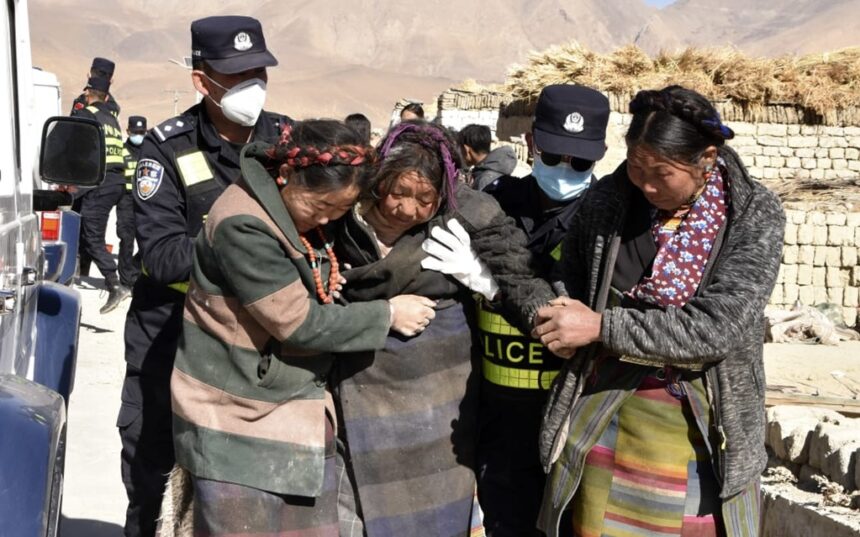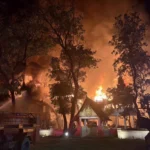A devastating magnitude 7.1 earthquake has claimed the lives of at least 126 individuals and caused significant damage to over 3,000 structures in a remote region of Tibet close to Mount Everest. Rescue teams are continued their efforts scouring the area for survivors.
Chinese state media reports that an additional 188 individuals sustained injuries following an earthquake that struck the foothills of the Himalayas at approximately 09:00 local time (01:00 GMT) on Tuesday. A significant rescue operation has been initiated, as survivors face heightened challenges with forecasts indicating temperatures could plummet to -16C overnight.
In a region known for its seismic activity due to its position on a significant geological fault line, Tuesday’s earthquake has emerged as one of the deadliest in China in recent years.
A magnitude 7.1 earthquake occurred at a depth of 10 kilometres (six miles), as reported by the US Geological Survey. The tremor was felt not only in Tibet but also in neighbouring regions, including Nepal and parts of India.
Footage released by China’s state broadcaster CCTV revealed scenes of devastation in Tibet’s revered Shigatse city, where homes have been reduced to rubble and buildings have collapsed. Rescue teams are seen navigating through the wreckage, distributing warm blankets to affected residents.
Tibet’s Temperatures
According to the China Meteorological Administration, temperatures in Tingri county, located near the earthquake’s epicentre in the northern foothills of the Himalayas, had already dropped to -8C before nightfall.
Sangji Dangzhi, the owner of a supermarket that sustained damage during the earthquake, reported that the devastation of homes in the area has been widespread.
“The houses in this area are constructed from dirt, which led to significant collapses during the earthquake,” the 34-year-old reported to BBC News via phone. He further noted that ambulances have been transporting individuals to hospitals throughout the day.
According to state media reports, by 19:00 local time, approximately 3,609 buildings had collapsed, raising concerns that thousands may be left without shelter.
A hotel resident in Shigatse reported to Chinese media outlet Fengmian News that he was abruptly awakened by a sudden wave of shaking. He reported that he quickly grabbed his socks and hurried onto the street, where he observed helicopters circling overhead.
“It felt as though the bed was being lifted,” he stated, noting that he recognised it was an earthquake due to the recent series of smaller quakes in Tibet.
Over 40 aftershocks
Disruptions to both power and water services have been reported in the region, which remains inaccessible to journalists. In the immediate aftermath of the quake, over 40 aftershocks were recorded within the first few hours.
Surveillance footage captures the dramatic moment a powerful earthquake hits the Tibet region of China. Chinese state media has reported that the earthquake registered a magnitude of 6.8, resulting in “obvious” tremors felt across the region.
The Chinese air force has initiated rescue operations and deployed drones to the impacted region.
President Xi Jinping has urged for comprehensive search and rescue operations aimed at reducing casualties and assisting displaced residents in their resettlement efforts.
An official from the National Emergency Operations Centre reported to BBC News that while strong tremors were experienced in Nepal, there were no significant damages or casualties. The official noted that there were only “minor damages and cracks on houses.”
Located near a significant fault line between the Indian and Eurasian tectonic plates, the region experiences regular seismic activity.
In 2015, a devastating magnitude 7.8 earthquake struck near Kathmandu, the capital of Nepal, resulting in the tragic loss of nearly 9,000 lives and leaving over 20,000 individuals injured.
Related News:
Engineers in Chiang Rai Work to Make Disaster Warning System

Geoff Thomas is an award winning journalist known for his sharp insights and no-nonsense reporting style. Over the years he has worked for Reuters and the Canadian Press covering everything from political scandals to human interest stories. He brings a clear and direct approach to his work.














